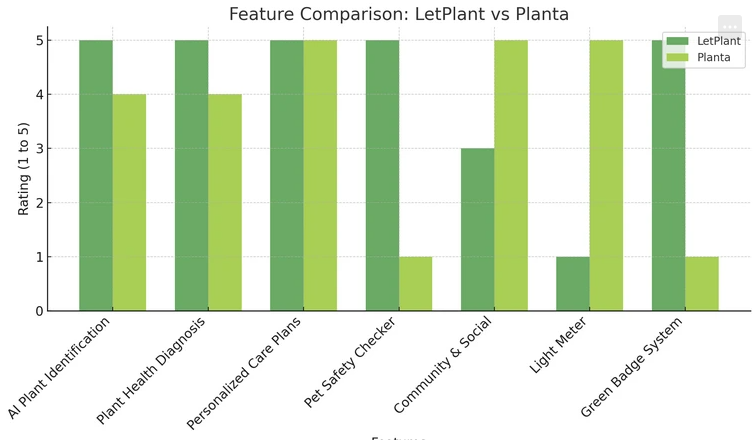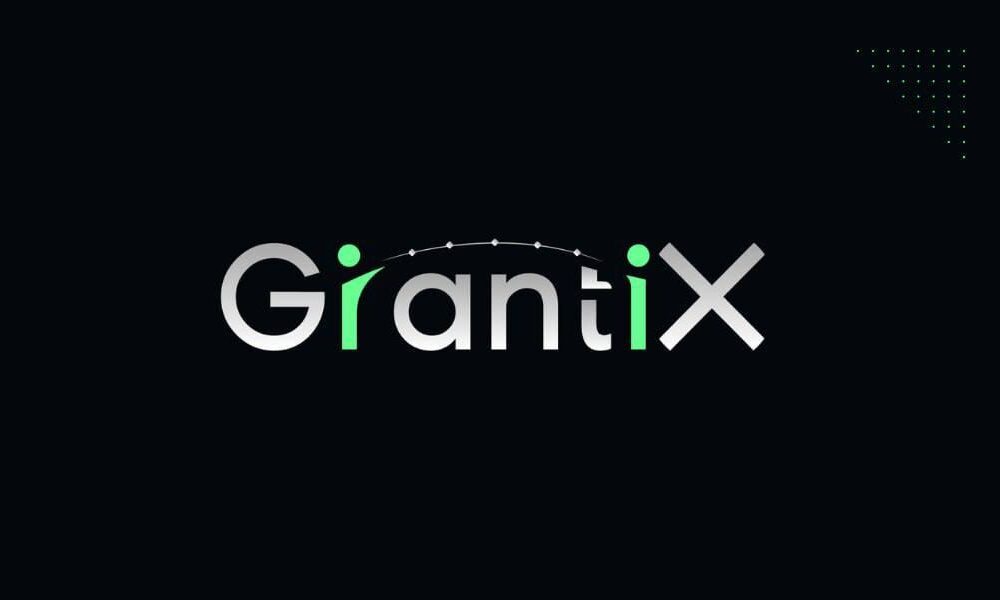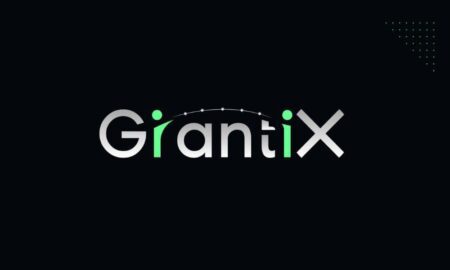LetPlant and Planta are two popular apps designed to help you keep your houseplants healthy. Both offer a range of tools for plant care, but they differ in approach. LetPlant is a newer, AI-driven app with innovative features, while Planta is a veteran app known for its reliable scheduling and large community.
Below, we compare their features, pricing, ease of use, and effectiveness for different plant care needs — with an emphasis on LetPlant’s unique strengths.
Features and Capabilities
Both apps cover the essentials of plant care (identification, care reminders, problem diagnosis, etc.), but each has its own standout features:
Plant Identification & Diagnosis:
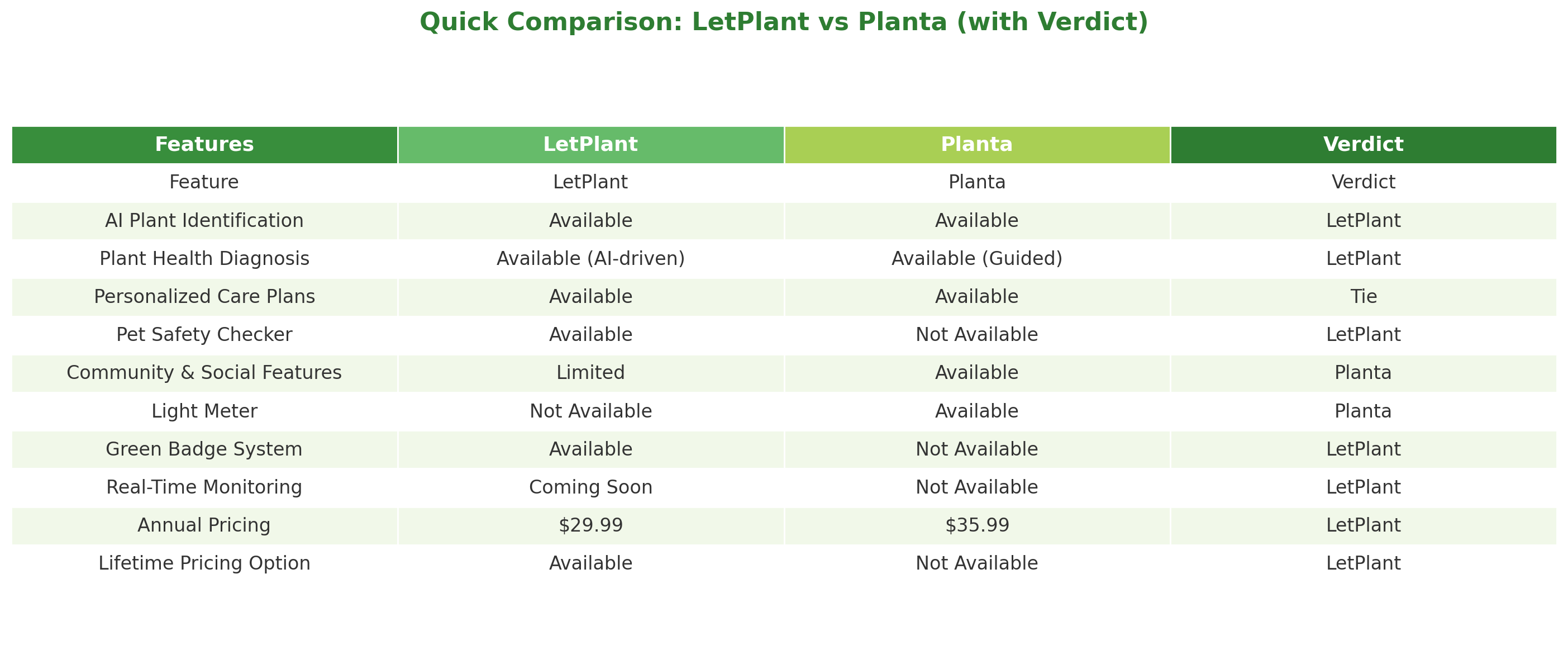
LetPlant uses advanced AI to instantly identify plant species and diagnose issues from a photo. Snap a picture of a leaf, and LetPlant’s AI will detect if there are pests, diseases, or nutrient deficiencies and suggest fixes.
LetPlant available on : iOS & Android
Planta also offers identification and a diagnosis tool called “Dr Planta,” which acts as a digital plant doctor. With Dr Planta, you answer a few questions or upload a photo of your ailing plant, and it provides likely causes (yellow leaves, pests, etc.) and treatment advice. Both apps help catch problems early, but LetPlant leans on AI for rapid answers, while Planta combines AI with a guided Q&A approach.
Personalised Care Plans & Reminders
Both apps generate care schedules tailored to each plant, but they do so differently.
LetPlant creates smart, personalised care plans by adjusting the watering frequency, lighting, and temperature requirements for specific species in your home.
It essentially anticipates what each plant needs—no more guessing how often to water your fern or if your ficus is getting enough sunlight. Planta, on the other hand, builds a schedule of care tasks (watering, fertilising, misting, repotting, etc.) for each plant after you input its details. Planta’s scheduling is impressively intelligent: it considers over 30 factors like species, pot size, season, and even local climate data to time reminders.
For example,
If it’s been very humid or rainy in your area, Planta might delay your watering reminder to prevent overwatering. The result is that Planta tells you exactly when to water or feed each plant. Meanwhile, LetPlant’s AI continuously adjusts to your plant’s needs in real time. Both methods promote healthier plants by eliminating uncertainty in plant care.
Pet-Friendly Plant Care:
A unique strength of LetPlant is its focus on pet safety. It has a built-in Pet Safety Checker that flags if a plant is toxic to cats or dogs.
For pet owners, this is invaluable – you can identify a houseplant and immediately see if it’s dangerous to your furry friends and even get suggestions for pet-safe alternatives.
Planta currently doesn’t have a dedicated pet toxicity feature, so this is a clear win for LetPlant if you have pets at home. LetPlant effectively bridges a knowledge gap by ensuring your plant choices are safe for the whole household.
LetPlant’s pet-friendly identification feature warns users if a houseplant (like a Monstera) is toxic to pets and suggests safer alternatives. This “Pet Safety Check” helps create a safe environment for both plants and animals. In this example, the app identifies a Monstera and cautions the user about its toxicity to pets.
Light & Environment Tools:
Planta includes a handy light meter feature, using your phone’s sensors to check light levels in different spots of your home. This helps you find the right place for a plant (e.g., it might tell you that corner is too dark for a cactus but fine for a snake plant).
LetPlant currently doesn’t have a light meter tool, but it emphasises environmental factors in other ways. Its plant library highlights which plants are good for indoor air quality (removing CO₂ and improving air health)
In fact, LetPlant encourages growing certain “air-purifying” plants to create a healthier living space, tying into its sustainability focus
In short, Planta directly measures your environment to guide plant placement, while LetPlant guides you to choose environmentally beneficial plants.
Community and Content:
Because Planta has been around longer, it has built an active user community and a rich knowledge base. Inside Planta, you’ll find a community forum and social feed where users share tips, photos, and plant stories. Planta also offers a library of plant care articles and step-by-step guides, covering everything from propagation to cleaning leaves.
This community vibe can make plant care more fun and social, as you can learn from others’ experiences. LetPlant, being newer, also provides community support—it has a forum for users to ask questions and share advice— but the user base is still growing
LetPlant offers a comprehensive plant library that provides detailed care information for numerous species, enabling you to access a wealth of knowledge at your convenience. Both apps aim to educate users, but Planta currently has the larger community and content repository, whereas LetPlant integrates its library with its AI for a more guided experience.
Gamification and the Green Badge System:
One of LetPlant’s novel features is its Green Badge system. This is a gamified reward system that encourages sustainable plant care habits. As you achieve certain milestones—for example, keeping a plant healthy for a certain period, reviving a sick plant with the app’s help, or completing all your tasks on time—LetPlant awards you a “green badge.” This adds a fun, motivational element to the app: users get recognition for their green thumbs, which can boost confidence and engagement.
Over time, collecting green badges helps users track their progress and dedication.
Planta does not have a comparable badge or achievement system. Its motivation for users comes more from seeing their plants thrive (and perhaps maintaining streaks with the reminder system), but it doesn’t explicitly reward you with badges. For users who love earning badges and milestones, LetPlant makes plant care feel a bit like a game — one where both you and your plants win.
AI and Future Tech (Real-Time Monitoring):
LetPlant positions itself at the forefront of plant care technology. It not only uses AI for software features but is also rolling out hardware integration. An upcoming addition called LetPlant SDESA is a smart sensor system for real-time monitoring of your plants’ environment.
This means LetPlant will be able to connect to smart pots or sensors that measure soil moisture, light, and temperature in real time, feeding that data into the app. The benefit for users is huge: the app could alert you before a problem occurs (for example, telling you a plant’s soil is drying out before the plant actually wilts). This kind of proactive, data-driven care is something LetPlant is focusing on. Planta’s approach, by contrast, is more traditional — it does not integrate with real-time sensors or IoT devices.
Planta sticks to scheduled reminders and user input, which works well but doesn’t offer live monitoring. So if you’re excited about smart home tech and the idea of getting alerts straight from your plants’ soil, LetPlant is the app to watch. By continuously tracking conditions, LetPlant’s system aims to prevent issues like overwatering or neglect, which keeps plants healthier and avoids wasting resources.
Subscription Pricing and Value for Money
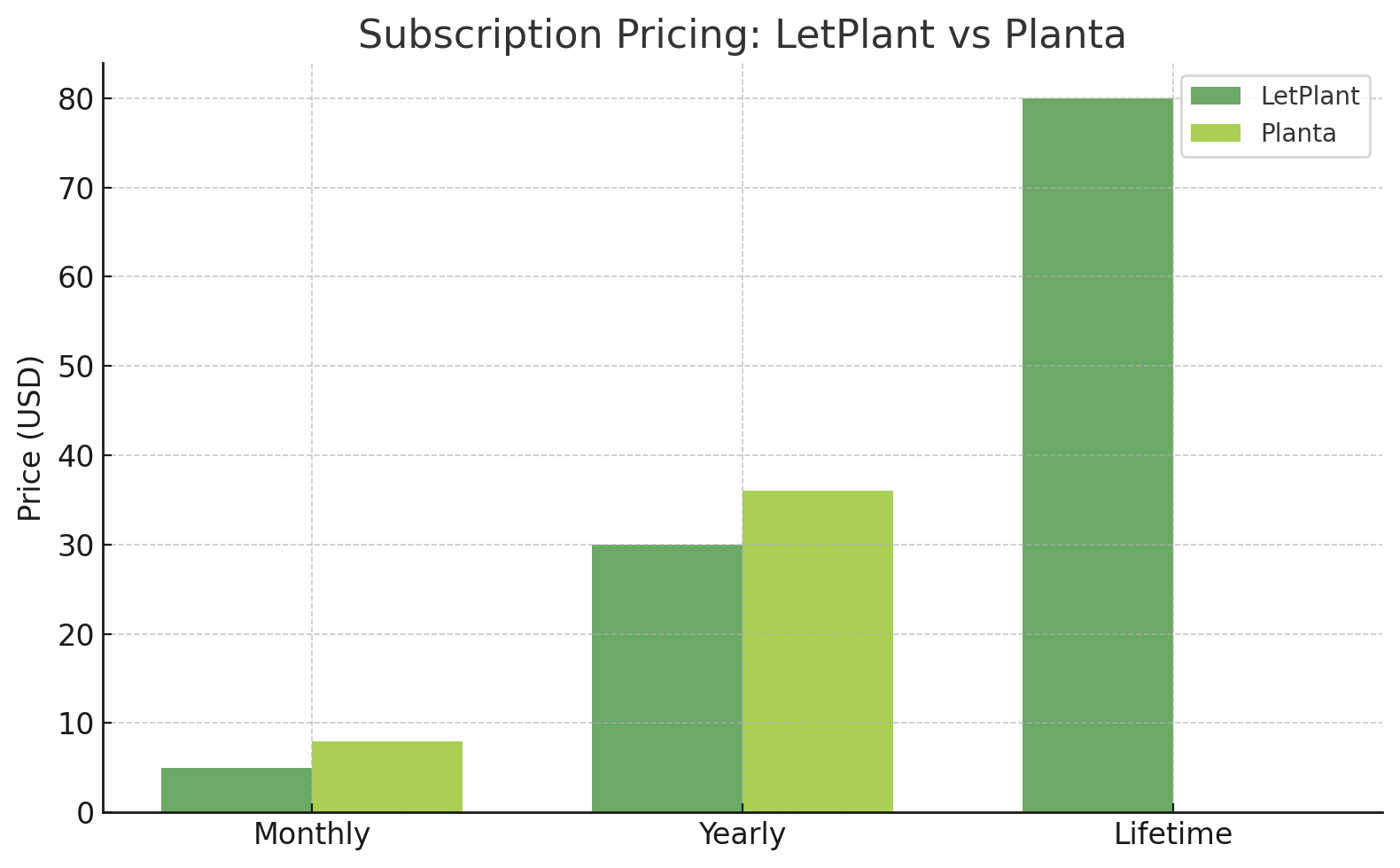
Both apps are free to download and use at a basic level, with optional premium subscriptions that unlock full functionality. Here’s how they compare on cost and value:
- LetPlant: The core features of LetPlant are free to use (you can identify plants, get care tips, and even use the AI diagnosis without charge):
This makes it very accessible for beginners. For advanced features, LetPlant offers a Premium subscription at $4.99 per month or about $29.99 per year.
iOS : apps.apple.com
which is modestly priced. Uniquely, LetPlant even offers lifetime purchase options: a one-time fee (around $79.99 for a “Lifetime – Believer” plan, or $49.99 for students) grants lifetime premium access
If you plan to use the app long-term, these options can offer great value for money. In summary, LetPlant’s pricing is quite affordable—its yearly plan comes out cheaper per month than Planta’s, and the availability of a lifetime licence is a strength for users who dislike recurring subscriptions. Despite the lower price, LetPlant still packs in high-tech features, so it scores well on value. - Planta: Planta’s basic version is also free but somewhat limited — for instance, free users get watering reminders and a few plant identifications per month. Many of Planta’s best features (unlimited plant IDs, detailed care schedules for all tasks, the Dr Planta diagnosis, etc.) require upgrading to Planta Premium . Planta’s premium subscription costs about $7.99 per month, with discounts for longer commitments (roughly $17.99 for 3 months or $35.99 per year)
At ~$36/year, it’s a bit higher in price than LetPlant, but still reasonable given the app’s depth. Serious plant enthusiasts often find the cost justified for the breadth of guidance Planta provides.
For example, paying members get full access to the huge plant library, all care reminders, the community features, and the plant health diagnostics. If you have a lot of plants or need the extra help, Planta’s subscription can be worth it. However, casual users on a tight budget might be fine sticking to the free tier or may find LetPlant’s free offerings more generous by comparison.
In terms of value, LetPlant gives you more advanced tech (AI, upcoming sensors) for a lower price, whereas Planta charges a bit more but offers a very comprehensive, time-tested service. Both have free versions, so you can try before investing in Premium.
User Interface and Ease of Use
A good app needs to be easy to navigate, especially when you’re managing dozens of leafy friends. Planta and LetPlant both prioritise user-friendly design, but there are some differences that reflect their ages and philosophies:
LetPlant’s Interface:
As a 2024-launched app, LetPlant has a modern, slick interface. Early users praise its “all-in-one” approach and responsive AI assistant, in practice, this means the app feels cohesive and straightforward.
The home screen typically shows your plant collection with quick access to identify a new plant or scan for problems. LetPlant’s design tends to highlight visual cues (for example, icons for water, sun, etc.) and uses notifications effectively to prompt you.
LetPlant presents the AI chat or diagnosis results clearly, enabling you to take immediate action. Because it bundles many features (ID, care plans, and forums) in one app, LetPlant tries to keep navigation simple— usually through a bottom menu or clear tabs for each function.
Overall,
users find it intuitive to get things done in the app. Since it’s newer, the interface is still evolving with user feedback, but it’s already slick and easy to use, even for beginners.
Planta’s Interface:
Planta, being a more mature app, is polished and very comprehensive. It has had several years to refine its design. The interface is clean, with a dashboard that might show your list of plants and their next care tasks. Users often mention they appreciate the peace of mind the app gives—“no plant will be forgotten,” as one review noted—and their satisfaction is partly due to how well the interface organises your tasks. Notifications from Planta are clear and timely (e.g., “Time to water your Aloe Vera!”). Navigation in Planta is typically via a menu where you can switch to the community section, the guides, or the light meter tool easily. Planta’s style is a bit more utilitarian (focused on the to-do list of plant care), which many users love because it’s like having a structured planner for your plants. It was even recognised as the app of the day in the App Store, indicating that its design and usability were top-notch. In short, Planta’s UI is intuitive and robust — it won’t wow with flashy AI graphics, but it’s reliable and clear, which is precisely what many plant parents need when juggling care schedules.
Both apps are easy to use, but if we compare them: LetPlant feels like a high-tech assistant with a sleek design, and Planta feels like a seasoned organiser that is simple and effective. New users should have no trouble with either, but you might prefer LetPlant if you like a more modern app aesthetic or Planta if you like seeing well-ordered lists of tasks.
Planta’s interface provides a clear list of care tasks (“today’s” to-dos, like watering or fertilising) for each plant, along with labels for location and health status. The app automatically schedules these tasks by considering factors like plant species, pot size, and even local weather data
We present this smart scheduling in an intuitive checklist format so you can simply follow along and “handle all tasks” by the due date.
Accuracy of Plant Identification and Health Diagnostics
When it comes to correctly identifying plants and diagnosing their health issues, both apps perform impressively, but there are a few nuances:
LetPlant: Thanks to its AI-driven engine, LetPlant can recognise “thousands of plant species with a simple photo” and pinpoint issues like pests or nutrient problems with notable accuracy.
In testing, it performs exceptionally well with common houseplants – for instance, it quickly distinguishes a peace lily from a philodendron, and if the leaves exhibit yellow spots, it may identify a fungal issue and recommend a treatment. Early adopters have found the AI diagnosis to be highly responsive and helpful.
Since LetPlant is new, its plant database is still growing, so there’s a possibility that very rare plant species or obscure diseases might not be immediately recognized
However, the app is continuously improving by learning from user scans. The personalised recommendations it gives are quite precise (e.g., it won’t just say, “Your plant is unhealthy”—it will say something like, “Looks like spider mites; here’s how to treat it”), which is a big confidence booster for users who aren’t plant experts. In summary, LetPlant’s identification and diagnostics are accurate for the vast majority of houseplants and getting better over time. Its proactive AI approach means it’s always “on”, looking for issues before they escalate.
Planta: Planta has the advantage of experience and a large user base behind it. Its identification feature is reliable for most houseplants—you snap a photo, and Planta will usually correctly name the plant and add it to your list. If it’s unsure, it might suggest a couple of options. The Dr Planta diagnostic feature has been praised for effectively diagnosing typical plant problems
By guiding the user through symptoms (or analysing a photo), it can determine common issues, like overwatering, nutrient deficiency, pest infestations, etc. The accuracy here is high for standard problems — Planta’s team has had time to refine the questions and image recognition to narrow down likely causes. Additionally, Planta claims to have a team of real plant experts behind the scenes, which likely contributes to the quality of its diagnoses and advice. Users often report that following Dr. Planta’s advice helped save their plants from dying. Both apps emphasize early detection: spotting something like yellow leaves early means you can act before the plant is beyond saving, which both LetPlant and Planta facilitate.
Overall, Planta’s identification and diagnostics are very accurate, especially for common scenarios, simply because the app has “seen” so many cases with its millions of users. It might not use fancy real-time AI for everything, but its combination of algorithms and expertlycurated content yields trustworthy results.
In practice, you can expect both apps to correctly identify your plant and give sound advice in most situations. LetPlant’s AI might feel more instantaneous and high-tech in its answers, while Planta’s system might feel like consulting a seasoned plant doctor.
One thing to note: Planta’s care recommendations are sometimes a bit rigid (since it sticks to a schedule), which can require manual adjustment if your conditions change, whereas LetPlant’s AI is designed to be adaptive.
But on the whole, both are effective at guiding even a novice to care for plants correctly, which is why their users have healthier, longer-living plants now.
Best Use Cases and User Recommendations
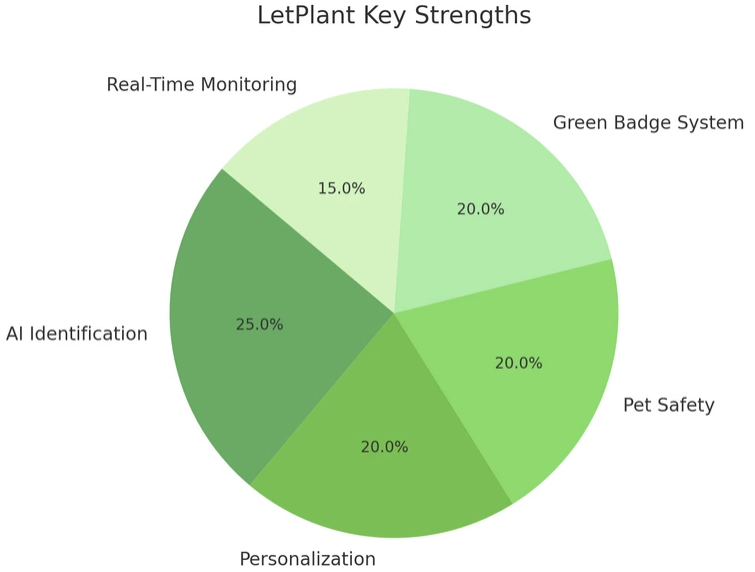
Choosing between LetPlant and Planta depends on your plant parenting style and app needs.
Here’s a breakdown of who benefits most from each app:
LetPlant is ideal for tech-savvy users, pet owners, and proactive caregivers:
If you love technology and want cutting-edge tools for your indoor garden, LetPlant will appeal to you. It’s ideal for busy or forgetful plant parents who want the app to do a lot of thinking for them — the AI will nudge you with exactly what your plant needs, and the upcoming sensor integration means you’ll get alerts without even opening the app.
LetPlant is also the better choice if you have pets, thanks to the pet-friendly plant identification that can literally be a lifesaver for cats and dogs.
Additionally, if you’re budget-conscious or hate subscriptions, LetPlant’s generous free features and one-time purchase options make it very accessible. It’s a perfect fit for someone who is enthusiastic about sustainability and learning — the Green Badge system rewards you for good habits, which can be motivating if you enjoy a bit of gamification.
In short, choose LetPlant if you want an innovative, AI-driven helper that not only tells you what to do, but also teaches you along the way and keeps both your plants and pets safe.
Planta is ideal for routine-orientated plant owners, collectors, and those who value community. If you have a large collection of plants or struggle to remember when to water which plant, Planta is like having a personal plant secretary.
It excels at creating an organised watering/feeding schedule so no plant gets neglected
This app is fantastic for users who prefer structure and don’t mind sticking to a routine—it will send you reminders, and you can even check tasks off a list, which is satisfying for checklist lovers.
Serious plant hobbyists with dozens of plants (ranging from succulents to ferns) will appreciate Planta’s extensive database and detailed care instructions for each species. If you enjoy being part of a plant community, Planta is the ideal choice.
You can browse others’ posts, ask questions, and share photos of your “plant babies,” all of which can enhance your learning and enjoyment.
While Planta’s premium subscription costs more, if you’re the type of user who wants every possible tool (light meter, diagnostic, unlimited plant profiles, etc.) and you’re okay with the price, you’ll get a lot of value out of it Choose Planta if you want a tried-and-tested system to keep your many plants alive and thriving, and if you like the idea of connecting with millions of other plant enthusiasts in-app.
Beginners and casual plant owners can honestly go with either app’s free version to start – it might even come down to personal preference after trying both. If you only have a couple of plants and mainly need simple watering reminders, Planta’s free tier might be enough and is very straightforward If you’re a newbie who also wants help identifying that mystery plant you got as a gift, or diagnosing why your fern’s leaves have brown spots, LetPlant’s free features will cover those extras (identification, basic diagnosis) without needing a subscription
For a casual user, LetPlant might feel more fun due to the AI and badge rewards, whereas Planta might feel reassuringly dependable with its schedules. You can’t really go wrong—both will prevent the common new-parent mistake of forgetting to water the plant until it is near death. Many users start with one app and switch or even use both to see which suits their style of care.
Final Recommendation
Both LetPlant and Planta are excellent plant care assistants ; they just cater to slightly different needs. As one expert review described, “If Planta is the seasoned instructor, LetPlant is the high-tech innovator” in the world of houseplant apps
Choose LetPlant if you value innovation, AI-driven insights, and features like pet safety checks and real-time monitoring. It’s perfect for someone who wants a forward-thinking app that evolves with technology (and it’s a bonus that it’s easier on the wallet, too)
LetPlant iOS : apps.apple.com
On the other hand, choose Planta if you prefer a well-established, comprehensive solution with a proven track record. It’s the reliable coach that will keep you on schedule and share a wealth of plant knowledge and community support
In the end, your personal preferences will determine the “best” app for you.
For tech enthusiasts, busy professionals, or households with pets, LetPlant offers strengths that are hard to beat.
For dedicated plant hobbyists, collectors, or those who thrive on routine and community, Planta remains a fantastic choice. The good news is that, regardless of which app you use, you’re more likely to turn your home into the thriving indoor jungle you envision— with healthier plants and a more confident you.
Happy planting!

